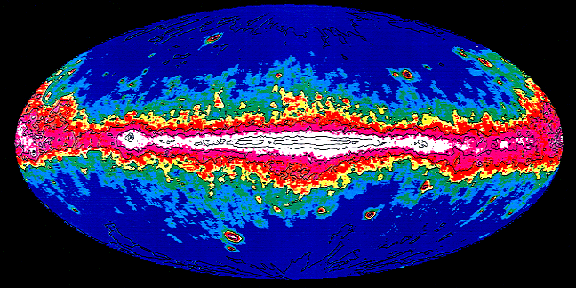
Glossary:
G and H
- Galactic
- Having to do with the galaxy.
- Galactic Cosmic Rays (GCRs)
- These cosmic ray particles come from outside our solar system, but from within our galaxy. They have lost all of their electrons during their trip through the galaxy.
- Galaxy

One of billions of large systems of stars and gas, held together by gravity, that make up the universe.- Gamma rays
 High energy electromagnetic radiation
(in excess of 100 keV) which can be generated by nuclear reactions
in space. This is an image of the EGRET gamma ray all-sky survey - above 100 MeV.
High energy electromagnetic radiation
(in excess of 100 keV) which can be generated by nuclear reactions
in space. This is an image of the EGRET gamma ray all-sky survey - above 100 MeV.- Gas
- A low number of atoms or molecules in a relatively large volume of space. Atoms or molecules are spread apart relative to each other.
- Gas-proportional counter
- An instrument that measures the point of impact of a particle and the energy loss of the particle through a gas inside the counter. There are gas-proportional counters are on the SEPICA instrument onboard the ACE spacecraft.
- Geocentric
- Based on the Earth as center; as, the geocentric theory of the universe.
- Geomagnetic storm
- A magnetic storm on Earth.
- GMT (Greenwich Mean Time)
- The local time at the 0 meridian passing through Greenwich, England; it is the same everywhere. Same as UT (Universal Time).
- Gradual flares
- One of two general types of solar flares. Gradual flares accelerate mostly protons and last for several days. They occur mainly near the poles of the Sun and happen, on average, about 100 times per year.
- Gravity
- A physical force attracting one object to another object.
- Ground station
- Ground stations are the link between the control system and a satellite in orbit. They track a satellite's signal to find it's location, and the status of equipment onboard and distribute that information to interested parties. They are also used to transmit operational signals back to the satellite to help control it.
- GSFC

The NASA/Goddard Space Flight Center in Greenbelt, MD.
G
H
- Helio-
- Prefix referring to the Sun.
- Heliocentric
- With the Sun at the center.
- Heliopause
- The gradual boundary between the heliosphere and the interstellar gas outside our solar system. See the diagram with the definition of "heliosphere" below.
- Heliosphere

The area in space that contains our solar system, solar wind, and the entire solar magnetic field. It extends well beyond the orbit of Pluto, out to the heliopause.- Helium
- The gas made from hydrogen in the core of stars by nucleosynthesis. Each atom of helium contains two protons.
- Hemisphere
- One half of a sphere or globe. The northern hemisphere on Earth is divided from the southern hemisphere by the equator.
- Hodoscope
- An instrument that determines the three-dimensional path of a particle through it. Hodoscopes are used in both the SIS and CRIS instruments on the ACE spacecraft.
- Hydrogen
- The most common gas in the universe. Each atom of hydrogen contains one proton.






Click on images above to
learn more about them
A service of the Heliophysics
Science Division at NASA's GSFC
Questions and comments to: cosmicopia@cosmicra.gsfc.nasa.gov
Curator: Dr Eric R. Christian, NASA
Responsible NASA Official: Dr Eric R. Christian
Privacy Policy and Important Notices
Questions and comments to: cosmicopia@cosmicra.gsfc.nasa.gov
Curator: Dr Eric R. Christian, NASA
Responsible NASA Official: Dr Eric R. Christian
Privacy Policy and Important Notices

HOME
In the News
History
Ask Us
Great Links
Glossary
Site Map
Search NASA